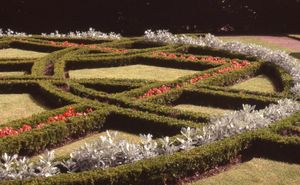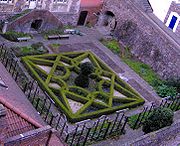
Knot garden
Encyclopedia

Herb
Except in botanical usage, an herb is "any plant with leaves, seeds, or flowers used for flavoring, food, medicine, or perfume" or "a part of such a plant as used in cooking"...
s including germander, marjoram
Marjoram
Marjoram is a somewhat cold-sensitive perennial herb or undershrub with sweet pine and citrus flavours...
, thyme
Thyme
Thyme is a culinary and medicinal herb of the genus Thymus.-History:Ancient Egyptians used thyme for embalming. The ancient Greeks used it in their baths and burnt it as incense in their temples, believing it was a source of courage...
, southernwood
Southernwood
Southernwood is a flowering plant. Found in Europe, the genus Artemisia was named for the goddess Artemis. Southernwood is known by many other names including Old Man, Boy's Love, Oldman Wormwood, Lover's Plant, Appleringie, Garderobe, Our Lord's Wood, Maid's Ruin, Garden Sagebrush, European Sage,...
, lemon balm
Lemon balm
Lemon balm , not to be confused with bee balm, Monarda species, is a perennial herb in the mint family Lamiaceae, native to southern Europe and the Mediterranean region....
, hyssop
Hyssop
Hyssop is a genus of about 10-12 species of herbaceous or semi-woody plants in the family Lamiaceae, native from the east Mediterranean to central Asia. They are aromatic, with erect branched stems up to 60 cm long covered with fine hairs at the tips. The leaves are narrow oblong, 2–5 cm...
, costmary
Tanacetum balsamita
Tanacetum balsamita, or Balsamita vulgaris, is a perennial temperate herb known as costmary, alecost, balsam herb, bible leaf, or mint geranium....
, acanthus
Acanthus (genus)
Acanthus is a genus of about 30 species of flowering plants in the family Acanthaceae, native to tropical and warm temperate regions, with the highest species diversity in the Mediterranean Basin and Asia. Common names include Acanthus and Bear's breeches...
, mallow
Malva
Malva is a genus of about 25–30 species of herbaceous annual, biennial, and perennial plants in the family Malvaceae , one of several closely related genera in the family to bear the common English name mallow. The genus is widespread throughout the temperate, subtropical and tropical regions of...
, chamomile
Chamomile
Chamomile or camomile is a common name for several daisy-like plants of the family Asteraceae. These plants are best known for their ability to be made into an infusion which is commonly used to help with sleep and is often served with either honey or lemon. Because chamomile can cause uterine...
, rosemary
Rosemary
Rosemary, , is a woody, perennial herb with fragrant, evergreen, needle-like leaves and white, pink, purple or blue flowers, native to the Mediterranean region. It is a member of the mint family Lamiaceae, which includes many other herbs, and is one of two species in the genus Rosmarinus...
, Calendula
Calendula
Calendula , pot marigold, is a genus of about 12–20 species of annual or perennial herbaceous plants in the daisy family Asteraceae, native to the area from Macaronesia east through the Mediterranean region to Iran...
s, Violas and Santolina
Santolina
Santolina is a genus of flowering plants in the family Asteraceae, native to the Mediterranean region. Between five and 24 species are accepted by different authorities....
. Most knot gardens now have edges made from box
Buxus
Buxus is a genus of about 70 species in the family Buxaceae. Common names include box or boxwood ....
(Buxus sempervirens), whose leaves have a sweet smell when bruised. The paths in between are usually laid with fine gravel. However, the original designs of knot gardens did not have the low box hedges, and knot gardens with such hedges might more accurately be called parterre
Parterre
A parterre is a formal garden construction on a level surface consisting of planting beds, edged in stone or tightly clipped hedging, and gravel paths arranged to form a pleasing, usually symmetrical pattern. Parterres need not have any flowers at all...
s.
Most Renaissance knot gardens were composed of square compartments. A small garden might consist of one compartment, while large gardens might contain six or eight compartments.
Examples

England
England is a country that is part of the United Kingdom. It shares land borders with Scotland to the north and Wales to the west; the Irish Sea is to the north west, the Celtic Sea to the south west, with the North Sea to the east and the English Channel to the south separating it from continental...
in the reign of Queen Elizabeth I.
Some early knot gardens have been covered over by lawn or other landscaping, but the original traces are still visible as undulations in the present day landscape. An example of this phenomenon is the early 17th century garden of Muchalls Castle
Muchalls Castle
Muchalls Castle stands overlooking the North Sea in the countryside of Kincardine and Mearns, Aberdeenshire, Scotland. The lower course is a well preserved double groined 13th century towerhouse structure, built by the Frasers of Muchalls. Upon this structure, the 17th century castle was begun by...
in Scotland
Scotland
Scotland is a country that is part of the United Kingdom. Occupying the northern third of the island of Great Britain, it shares a border with England to the south and is bounded by the North Sea to the east, the Atlantic Ocean to the north and west, and the North Channel and Irish Sea to the...
.
Knot gardens have become established in many temperate formal gardens throughout the world, including:
- Antony HouseAntony HouseAntony House is the name given to an early 18th-century house, which today is in the ownership of the National Trust. It is located between the towns of Torpoint and the village of Antony in the county of Cornwall, United Kingdom...
, CornwallCornwallCornwall is a unitary authority and ceremonial county of England, within the United Kingdom. It is bordered to the north and west by the Celtic Sea, to the south by the English Channel, and to the east by the county of Devon, over the River Tamar. Cornwall has a population of , and covers an area of...
, England - St Fagans, South WalesWalesWales is a country that is part of the United Kingdom and the island of Great Britain, bordered by England to its east and the Atlantic Ocean and Irish Sea to its west. It has a population of three million, and a total area of 20,779 km²...
- Alexandra Hicks Herb Knot Garden, University of MichiganUniversity of MichiganThe University of Michigan is a public research university located in Ann Arbor, Michigan in the United States. It is the state's oldest university and the flagship campus of the University of Michigan...
- KnowleKnowleKnowle is a large village a few miles southeast of the town of Solihull, UK. Knowle lies within the historic county boundaries of Warwickshire, and since 1974 it has been part of the Metropolitan Borough of Solihull within the West Midlands...
, SolihullSolihullSolihull is a town in the West Midlands of England with a population of 94,753. It is a part of the West Midlands conurbation and is located 9 miles southeast of Birmingham city centre...
, England - Brooklyn Botanic GardenBrooklyn Botanic GardenBrooklyn Botanic Garden is a botanical garden in the borough of Brooklyn in New York City. Located near the Prospect Heights, Crown Heights, and Park Slope neighborhoods, the garden includes a number of specialty "gardens within the Garden," plant collections, and the Steinhardt Conservatory,...
, New YorkNew YorkNew York is a state in the Northeastern region of the United States. It is the nation's third most populous state. New York is bordered by New Jersey and Pennsylvania to the south, and by Connecticut, Massachusetts and Vermont to the east... - Anzac Square, DunedinDunedinDunedin is the second-largest city in the South Island of New Zealand, and the principal city of the Otago Region. It is considered to be one of the four main urban centres of New Zealand for historic, cultural, and geographic reasons. Dunedin was the largest city by territorial land area until...
, New ZealandNew ZealandNew Zealand is an island country in the south-western Pacific Ocean comprising two main landmasses and numerous smaller islands. The country is situated some east of Australia across the Tasman Sea, and roughly south of the Pacific island nations of New Caledonia, Fiji, and Tonga... - Red Lodge MuseumRed Lodge Museum, BristolThe Red Lodge Museum is an historic building in Bristol, England.It is open to the public is a branch of Bristol City Museum and Art Gallery.- History :...
, BristolBristolBristol is a city, unitary authority area and ceremonial county in South West England, with an estimated population of 433,100 for the unitary authority in 2009, and a surrounding Larger Urban Zone with an estimated 1,070,000 residents in 2007...
, England - Western Reserve Herb Society, Cleveland Botanical GardenCleveland Botanical GardenCleveland Botanical Garden, located in the University Circle neighborhood of Cleveland, Ohio, in the United States, was founded in 1930 as the Garden Center of Greater Cleveland. It was the first such organization in an American city...
- Hatfield HouseHatfield HouseHatfield House is a country house set in a large park, the Great Park, on the eastern side of the town of Hatfield, Hertfordshire, England. The present Jacobean house was built in 1611 by Robert Cecil, First Earl of Salisbury and Chief Minister to King James I and has been the home of the Cecil...
, HertfordshireHertfordshireHertfordshire is a ceremonial and non-metropolitan county in the East region of England. The county town is Hertford.The county is one of the Home Counties and lies inland, bordered by Greater London , Buckinghamshire , Bedfordshire , Cambridgeshire and...
, England
See also
- Herb garden
- History of gardeningHistory of gardeningThe history of ornamental gardening may be considered as aesthetic expressions of beauty through art and nature, a display of taste or style in civilized life, an expression of an individual's or culture's philosophy, and sometimes as a display of private status or national pride—in private...
- Pizza garden
- Potager garden
- Gardens of the French RenaissanceGardens of the French RenaissanceThe Gardens of the French Renaissance is a garden style largely inspired by the Italian Renaissance garden, particularly the gardens of Florence and Rome. King Charles VIII and his nobles brought the style back to France after their campaign in Italy in 1495...
- Garden à la françaiseGarden à la françaiseThe French formal garden, also called jardin à la française, is a style of garden based on symmetry and the principle of imposing order over nature. It reached its apogee in the 17th century with the creation of the Gardens of Versailles, designed for Louis XIV by the landscape architect André Le...

